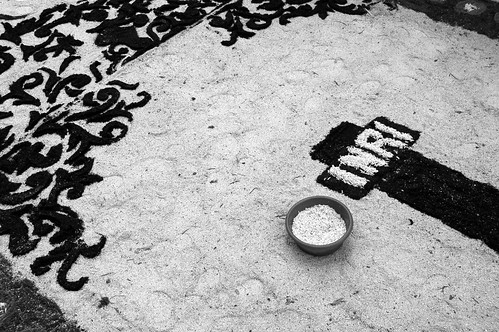 The photo department finally got through editing all 500 pictures down to a brisk 85 or so and getting them on-line, just in time for the editorial staff to make a hasty end-of-"summer" trip to the beach. We know that our loyal readers are sitting at home on Saturday nights hitting "refresh" on the Holla website every five minutes waiting for news. So, we apologize, and will forgo our usual lengthy introduction and cut to the equally lengthy chase.
The photo department finally got through editing all 500 pictures down to a brisk 85 or so and getting them on-line, just in time for the editorial staff to make a hasty end-of-"summer" trip to the beach. We know that our loyal readers are sitting at home on Saturday nights hitting "refresh" on the Holla website every five minutes waiting for news. So, we apologize, and will forgo our usual lengthy introduction and cut to the equally lengthy chase.We had heard that the crowds in Antigua were unbearable for the Semana Santa (Holy Week) processions, and were almost ready to skip the whole thing. But we figured it was worth a try, and if we couldn't find anywhere to park we would just turn around and head home. Lucky for us, the rumors of unbearable crowds were greatly exaggerated.
On Thursday afternoon and evening, and Good Friday morning, we wandered around the town, seeing how they make some of the less elaborate alfombras and seeing a few parades. "Alfombra" translates as "carpet," and refers to the elaborate decorations that the local residents build on the cobblestone streets in front of their homes and businesses. It is a painstaking process of collecting bushels of flower petals and seeds, arranging them in elaborate patterns, outdone only by the even more elaborate and intensely colored sawdust artworks. The ones we saw on Thursday were mostly pretty basic, but on Friday morning they were incredibly intricate, often the work of the entire night by a team of laborers. Each alfombra is then trampled by a parade. There must be some sort of symbolism there.
We managed to catch three parades, which ostensibly had scheduled stops around town, though they were best thought of as a rough suggestion of the route rather than a real timetable. Each parade follows a fairly standard pattern:
1. The Roman guards. Sometimes on horseback.
2. Guys in the purple robes start lining the street, then guys with censers of incense amble through, accompanied by guys in non-purple robes. For the Good Friday procession, the sea of purple robes was particularly thick. These guys mostly just stand around -- they may carry special poles that lift power lines out of the way of the very tall sculptures to follow, or may just be waiting their turn to carry the sculptures. In fact, you see people of all ages running around in purple robes all over the place, all day.
3. An anda featuring Jesus carrying the cross. An anda is like a giant sedan carried by sixty or seventy people, half on each side. Nobody I know has been able to come up with an equivalent word in English -- since "float" generally conjures images of the goofy Rose Parade floats with animatronic dinosaurs and whatnot.
4. A marching band
5. Anyone who feels like joining in the parade for a bit, mostly apparently very devout elderly folks.
6. Some other random folks on little four-person andas. Maybe if I'd been to a bit more church in my day, I could tell my Mary Magdalenes from my Josephs and John the Baptists.
7. Mary, carried by women, all in black veils, probably because the ladies wanted something that they would be able to wear again, unlike the purple robes.
8. Another marching band.
9. Cleaning trucks, backhoes, etc.
10. Everyone else in the world, selling all manner of food and toys.
The processions were as spectacular as billed (book now for Semana Santa 2007), even without the main event, which is the candlelight procession on Friday night. Instead, we shot up to Lake Atitlan, where a friend was working as a volunteer at a medical clinic in the small town of San Lucas Toliman. The big bonus of this was the extremely friendly family she was staying with that allowed us to -- or perhaps begged us to -- help build the alfombra on their street. The San Lucas processions were on a smaller scale, with far more indigenous flare and far fewer tourists, but the alfombras were still impressive and the joy of seeing our own work trampled brought us closer to to the event. We saw Jesus taken down from the cross in the local church, and had an amazing view from the bell tower as his body was led out for the final procession of the day.
One interesting note in Toliman was the local version of Maximon (whom faithful readers may remember) was hanged from the church, apparently because one of the many figures mixed into his composite character is Judas.
It turns out that nothing actually happens on Holy Saturday -- it's mostly just a day for fun with the family between the processions of Good Friday and the churching up of Easter Sunday. There were lots of families at the lakefront, and a mini-carnival with food stands and midway games in the main square. We spent the day wandering and allowing the staff photographer to play with his new toys.
Unsurprisingly, Sunday is all about church -- though there is one last procession (I hear it features the empty coffin coming back to the church, although your correspondent was unprepared for the early start required on Sunday morning to see it). But life also seemed to be back to normal, with things feeling a little sleepy. Maybe everyone was in church, or maybe your correspondent wasn't the only one with a hangover, or most likely, both.




No comments:
Post a Comment